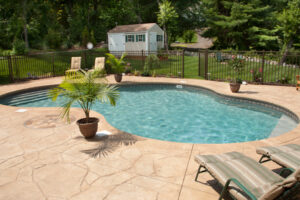
There are pool heating options and strategies beyond just hooking up a pool heater and accepting the higher utility bills.
When it comes to enjoying your pool throughout the year while minimizing energy costs, choosing the right pool heating options is pretty crucial. By implementing certain simple yet effective strategies, you can optimize heat retention, reduce heat loss, and save yourself some cash in the process.
Read along below to learn more about key pool heating options and strategies to help you make informed decisions.
Insulation for Energy Efficiency
To maximize energy savings and lower long-term heating costs, incorporating rigid panel insulation in and around your pool structure is highly recommended. Whether you have a Natural pool or a swimming pond, proper insulation acts as a vital barrier against heat loss. The ambient temperature of the ground is typically colder than the ideal swimming temperature, making insulation essential. By investing in insulation, you create a thermal barrier that prevents heat from escaping, significantly reducing the need for excessive heating. By taking this proactive step, you can enjoy a more energy-efficient pool and experience substantial cost savings in the long run.
Strategic Equipment Planning
During the planning and installation phase, it is crucial to consider future heating options by incorporating additional valves in your pipe runs. This forward-thinking approach enables easy retrofitting of pool heating systems such as heat pumps or solar panels. By proactively planning your equipment setup, you can avoid costly modifications down the line and ensure that you have the most efficient heating systems for your pool. Strategic equipment planning not only saves money in the long term but also provides the flexibility to adapt to evolving pool heating technologies, allowing you to maximize energy efficiency and optimize cost savings.
Pool Siting Considerations
Choosing the ideal location for your pool is a critical factor in achieving optimal heating efficiency. Ideally, your pool should be situated to maximize sun exposure while being shielded from the wind. Sun exposure facilitates passive solar heat gain, while wind can accelerate heat loss through evaporation. By strategically siting your pool in an area that receives ample sunlight and is protected from wind, you can enhance solar gain, reduce heating requirements, and minimize energy costs. Thoughtful pool siting plays a significant role in maintaining comfortable water temperatures and extending your swimming season without incurring excessive heating expenses.
The (Surprising) Impact of Pool Color
Believe it or not, the color of your pool can have a significant impact on its ability to absorb and retain heat. In hot climates, opting for a darker-colored pool can enhance solar absorption, effectively raising the water temperature. Conversely, in colder climates, a lighter-colored pool can reflect sunlight and prevent excessive heat loss. By carefully selecting the appropriate pool color based on your specific climate and heating needs, you can optimize solar gain and minimize the energy required for heating. This strategic approach allows you to enjoy a comfortable pool environment while keeping operational costs in check.
Closing Thoughts
Implementing efficient pool heating strategies can significantly reduce energy costs while ensuring a comfortable swimming experience. Whether you opt for solar heating, a heat pump pool heater, or a combination of both, taking an active and informed approach to pool heating will both save you considerable money and help ensure a full season’s worth of fun in the pool.
Do You Have More Questions About Pools? Ask Sunrise Premiere Pool Builders LLC
If you still have questions about how to build a brand new swimming pool, Sunrise Premiere Pool Builders LLC is here to help you. At Sunrise Pools, we can build and install your pool, spa, or hot tub and provide you with pool chemicals, services, and more. If you have questions, feel free to give us a call at 410-349-3852. To see more from us and for tips and tricks, be sure to follow us on Facebook, Twitter, Pinterest, and LinkedIn.
